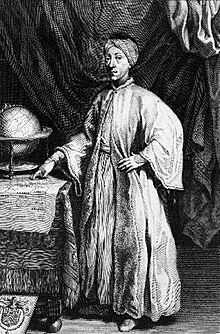Jean de Thévenot facts for kids
Quick facts for kids
Jean de Thévenot
|
|
|---|---|
 |
|
| Born | 16 June 1633 |
| Died | 28 November 1667 Mianeh
|
| Nationality | French |
| Occupation | Traveller |
Jean de Thévenot (born June 16, 1633 – died November 28, 1667) was a famous French explorer. He traveled a lot in the East and wrote many books about his adventures. Jean was also very smart. He knew many languages, studied nature, and was especially good at learning about plants. He was born in Paris and went to school at the Collège de Navarre. His uncle was Melchisédech Thévenot, who was also a well-known person.
Contents
Jean's First Adventures in Europe (1652-1655)
Jean loved reading about other people's travels. This made him want to explore the world himself. Luckily, he had enough money to make his dreams come true. In 1652, he left France. His first trips were to England, the Netherlands, Germany, and Italy.
While in Rome, he met a man named D'Herbelot. D'Herbelot invited Jean to join him on a trip to the Levant. The Levant is a historical name for the countries along the eastern coast of the Mediterranean Sea. D'Herbelot couldn't go right away, but Jean decided to sail alone in May 1655. He waited five months in Malta, but D'Herbelot never arrived. So, Jean continued his journey to Constantinople by himself.
Exploring the Near and Middle East (1655-1663)
Jean stayed in Constantinople until August of the next year. Then, he traveled to Smyrna and the Greek islands. He finally arrived in Egypt on New Year's Day, 1657. He spent a whole year exploring Egypt. After that, he visited the Sinai Peninsula.
When he returned to Cairo, he joined a group of pilgrims. They were traveling to Jerusalem for Lent. Jean visited many important religious sites in Palestine. On his way back, he was captured by pirates twice! Luckily, he managed to get back to Damietta by sea. He was in Cairo again in time to see the opening of the canal. This happened when the Nile River rose on August 14, 1658.
In January 1659, he sailed from Alexandria on an English ship. On this journey, he stopped at Goletta and Tunis in Tunisia. His ship even fought off some Spanish pirates! The English ship won, taking one of the pirate ships as a prize. Jean finally reached Leghorn in Italy on April 12. He then spent four years at home. During this time, he studied things that would help him on future travels.
More Journeys to the East (1663-1667)
In November 1663, Jean set sail for the East once more. He stopped in Alexandria and landed in Sidon. From there, he traveled by land to Damascus and Aleppo. He then went through Mesopotamia to Mosul, Baghdad, and Mendeli.
He entered Persia on August 27, 1664. He traveled through Kermanshah and Hamadan to Isfahan. He stayed in Isfahan for five months, from October 1664 to February 1665. Then, he joined another famous traveler, Jean-Baptiste Tavernier. They traveled together through Shiraz and Lar to Bander-Abbasi. They hoped to find a ship to India.
It was hard to find a ship because the Dutch were causing problems. Tavernier was able to continue his journey, but Jean decided it was safer to go back to Shiraz. He visited the ancient ruins of Persepolis. Then, he made his way to Basra and sailed for India on November 6, 1665. He arrived at the port of Surat on January 10, 1666.
Jean stayed in the Mughal Empire of India for thirteen months. He traveled across the country from Golconda to Masulipatam. He then returned overland to Surat. From Surat, he sailed back to Bander-Abbasi and went up to Shiraz. He spent the summer of 1667 in Isfahan. He was recovering from an accidental pistol shot. In October, he started his journey to Tabriz. Sadly, he died on the way in Mianeh on November 28, 1667.
Jean's Amazing Skills
Jean de Thévenot was a very talented person. He was a polyglot, meaning he could speak many languages. He was skilled in Turkish, Arabic, and Persian. He was also a careful and curious observer of the world around him.
He was very good at natural sciences, especially botany, which is the study of plants. He collected many plants during his travels in India.
Jean's Travel Books
The story of his first journey was published in Paris in 1665. It was called Relation d’un voyage fait au Levant. This book became the first part of his collected Voyages. Jean himself prepared the book for publishing before he left on his second journey. In his writings, he was one of the first European travelers to share a story about the Achtiname of Muhammad. This is an old Arabic document that claims the Islamic prophet, Muhammad, gave special protection to the monks of Saint Catherine's Monastery in Egypt.
The second and third parts of Jean's Voyages were published after he died. They came out in 1674 and 1684. A full collection of his travels was published in Paris in 1689. An early English translation was also made in 1687.
See also
- Orientalism in early modern France
Primary sources
- Thévenot, Jean de. Relation d’un voyage fait au Levant. Paris: L. Billaine, 1665.
- Thévenot's Voyages on Gallica

